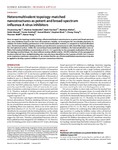Heteromultivalent topology-matched nanostructures as potent and broad-spectrum influenza A virus inhibitors
Nie, Chuanxiong
Stadtmüller, Marlena
Parshad, Badri
Wallert, Matthias
Ahmadi, Vahid
Kerkhoff, Yannic
Bhatia, Sumati
Block, Stephan
Cheng, Chong
Wolff, Thorsten
Haag, Rainer
Here, we report the topology-matched design of heteromultivalent nanostructures as potent and broad-spectrum virus entry inhibitors based on the host cell membrane. Initially, we investigate the virus binding dynamics to validate the better binding performance of the heteromultivalent moieties as compared to homomultivalent ones. The heteromultivalent binding moieties are transferred to nanostructures with a bowl-like shape matching the viral spherical surface. Unlike the conventional homomultivalent inhibitors, the heteromultivalent ones exhibit a half maximal inhibitory concentration of 32.4 ± 13.7 μg/ml due to the synergistic multivalent effects and the topology-matched shape. At a dose without causing cellular toxicity, >99.99% reduction of virus propagation has been achieved. Since multiple binding sites have also been identified on the S protein of SARS-CoV-2 (severe acute respiratory syndrome coronavirus 2), we envision that the use of heteromultivalent nanostructures may also be applied to develop a potent inhibitor to prevent coronavirus infection.
Dateien zu dieser Publikation

